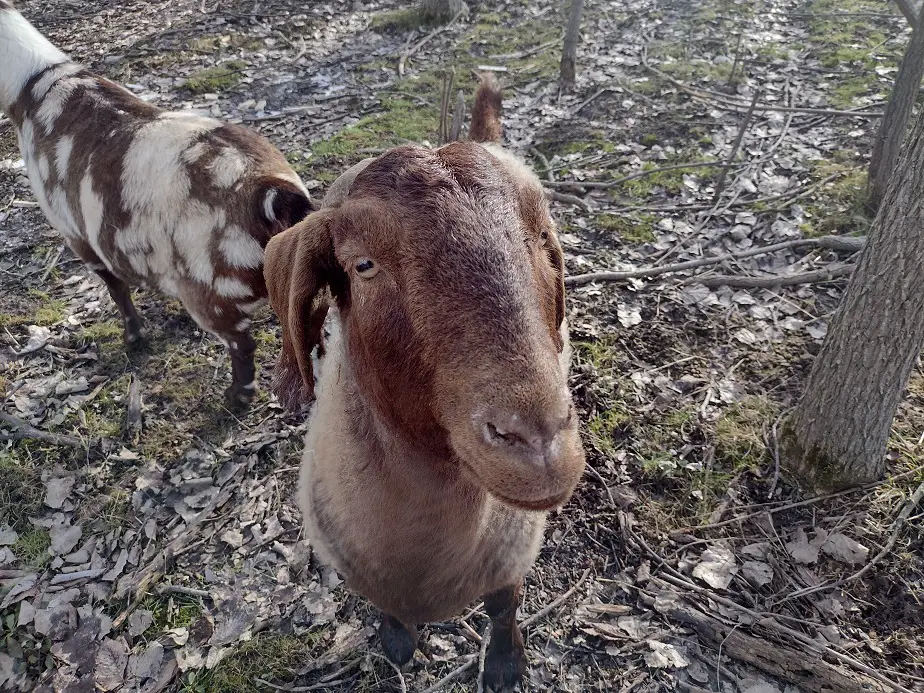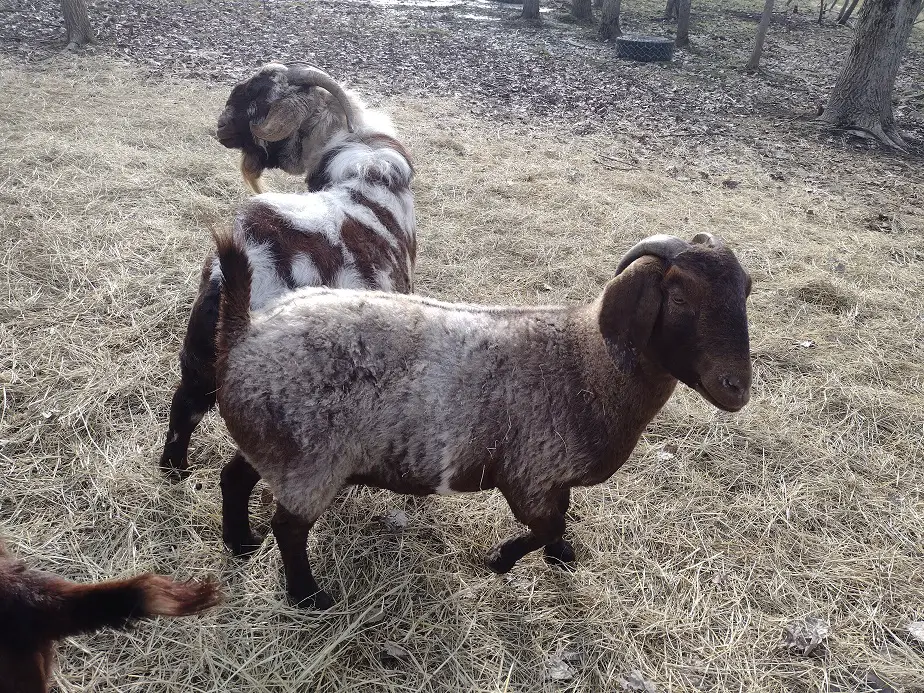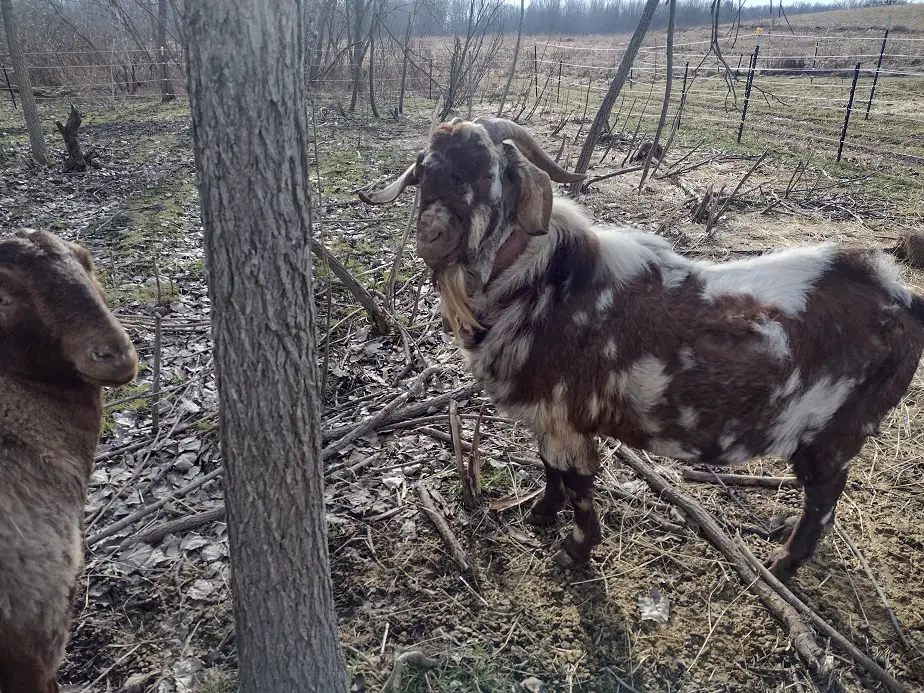We’ve really been experimenting with pasture crops to see just what will “live of the land”.
Goats can live on just hay. In most countries, goats are fed little more than hay or wild fodder. Pregnant does usually benefit from some grain as an energy additive. Young goats will grow better with some grain, but decent hay will feed a goat quite well.
It really boils down to your goals and the type of hay available in your area. It can do well, or it can create issues.
Raising Goats on Just Hay or Pasture
There are three types of feed for goats: hay, pasture, and grains.
- Hay- less nutrition and protein than fresh greens, will sustain most goats.
- Pasture- the most nutritious, mid to high protein.
- Grains- high energy, low protein/vitamin/minerals. Good if extra calories are needed, can make goats fat.
In decent weather, goats can be and should be raised as much as possible on pasture forage. Pasture forage, which is live growing greens, is the best general diet for goats. Grains do not contain any significant vitamins and are low in essential minerals.
If you have good hay, you can raise goats pretty well on it. If you have really good hay, they can do quite well. Hay can have a wide range of nutrients, depending on its age, how it was stored, and if it was a high-nutrition crop in the first place.
Hay is cut and dried pasture forage. Once the plant matter has been harvested, it begins to rapidly lose its vitamin content as some of the volatile compounds break down. It also begins to decrease its protein content as the hay ages. Fresh is better than hay, and new hay is better than old hay.
Gras hay, if fairly fresh, is decent goat hay. It should still have some green color and have the sweet hay smell to it. That’s how you know it’s at least decent. Older hay will be bleached or rain-rinsed to a tan color and will smell old or musty. Fresh hay is good hay for goats.
Low-quality hay can sustain non-bred goats in hard times, but even young goats will not grow much on it. There’s just not enough starch, protein, and vitamin content left in it to support good health and growth.
Good-quality hay can be a complete feed for young goats and pregnant/nursing does. I’m talking a high-protein, high-vitamin crop that was stored well. The creme of the crop of hay is alfalfa. Alfalfa is a high in protein, and very high in vitamins and as long as it’s been stored well, it’s good stuff.
If you were considering planting a pasture for goats, you have the option of lesser common perennial crops like clover, chickory, or comfrey. Honestly, a mix of several would be amazing. These are all high-protein, high-vitamin, high-mineral fodder crops that grow pretty good anywhere that good grass would grow.
Most goats will eat several, 2-4, pounds of hay a day. In cold weather, they need more. Grains may also be needed in bad-wintery weather, especially if the hay quality isn’t so great.

Tree Leaves for Goats
Tree leaves can be used as goat feed, both fresh and dried for hay. Tree leaves are very high in protein and minerals, but lower in vitamins. Some traditional farmers still harvest green tree boughs and bundle them for hay. Fresh or dried, tree hay as it’s called is a very good feed option for goats.
Some of the best leaves are beech, birch, and poplar. Green leaves have good nutrition for goats, dried brown leaves do not. There are no common tree species that have toxic-to-goat leaves. Red Maple can pose toxicity to horses, but not to goats it seems.
Trees used as goat fodder are often polled, which means cutting the main trunk short so a lot of low-hanging brushy branches grow out from it. If you burn wood for fuel, consider cutting trees in the summer and bundling the green boughs together for hay.

Do Goats Need Grain?
Goats don’t need grain unless pasture or hay isn’t providing enough energy. If your animals are looking thin or underfed, first increase the hay allowance, then offer some grains if needed. Pregnant or nursing goats tend to benefit from the extra calories and have larger litters when fed some grain.
If I was going to buy grain for goats, I’d go with whole corn and/or whole oat. It’s what’s available locally at a good price. Goats chew the whole-grains decently, so they’ll digest it pretty well, but you can speed up the metabolic breakdown by soaking or fermenting the grains first.
Fermenting grains actually increases the protein and vitamin content greatly. That knowledge can be pretty handy. If you need extra protein for growing young or a pregnant doe, I’d play around with a 2 to 4-day fermented, whole grain.
A molasses grain or sweet feed has even more calories than bare grain, but it’s usually more economical just to feed a bit extra grain if they actually need it. Adding molasses to goat feed is only needed if they can’t eat enough to get proper calories without it.
Plus, an average day’s worth of sweet feed only has about a teaspoon of molasses (20 calories) added. Molasses actually has fewer calories per pound than grains, and it costs more per calorie than basic grains.
All it really does is fill in some of the gaps in the grain and convince the animals to eat more. I’m not really big on molasses, but have used it to boost the fermentation of my grains. It may be worth it for that.
Keep an eye on your goat’s physique. Most goats are supposed to look a bit thin, but if they look a bit ragged or unhealthy, you really need to correct something, usually their diet.
Related Articles:

